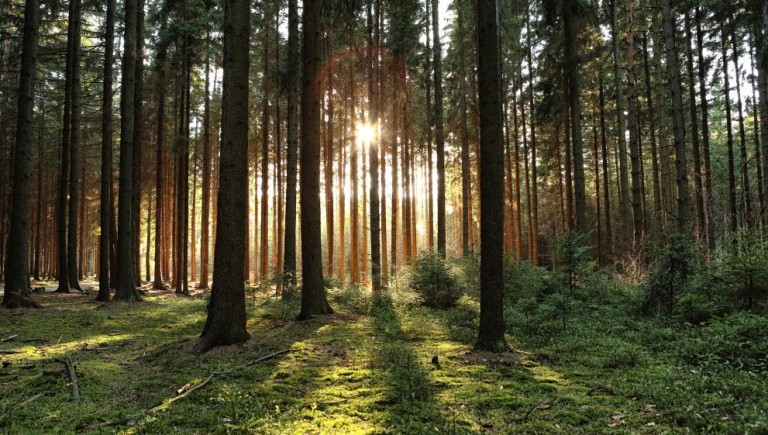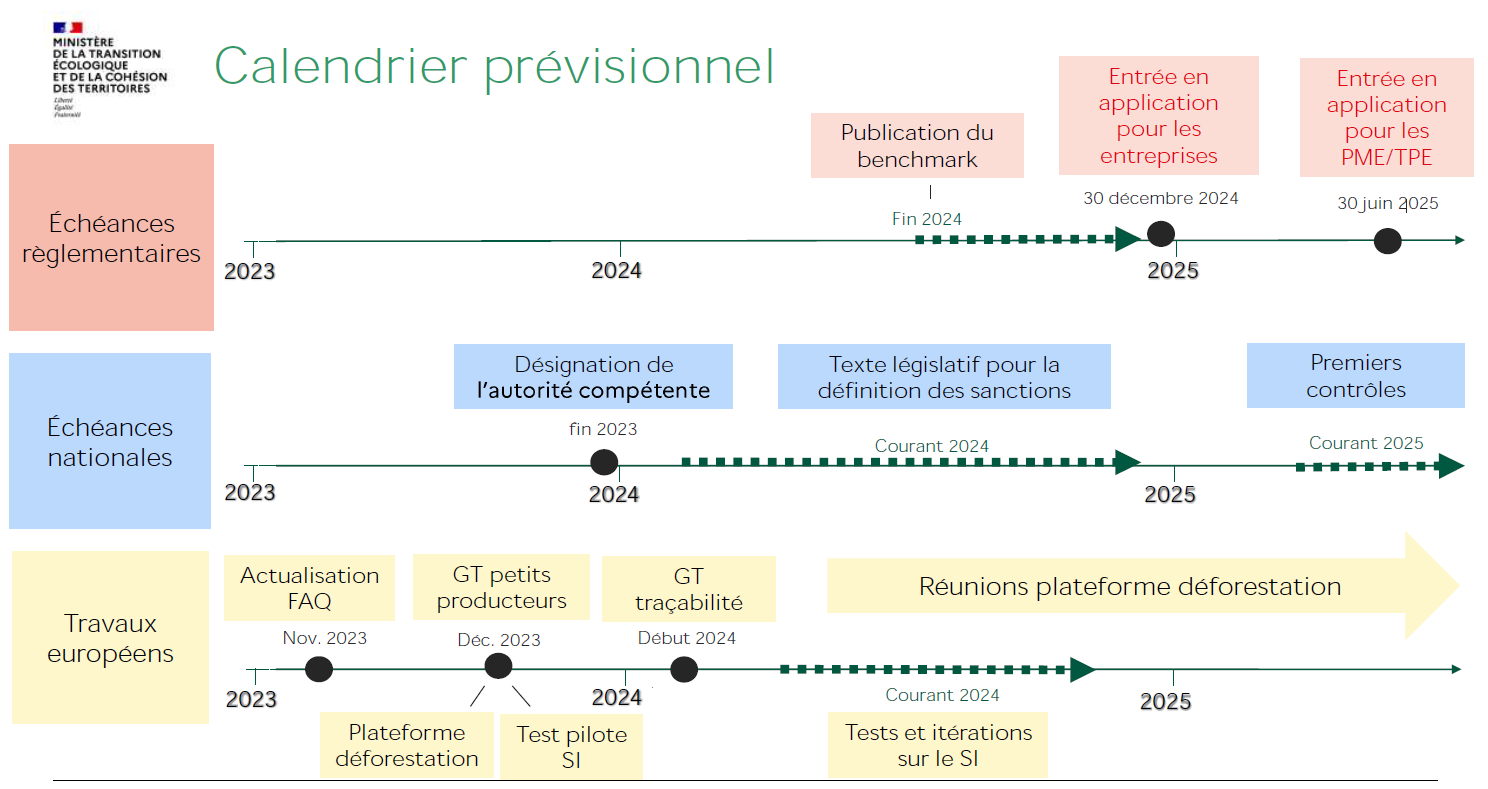

15.12.2023
Concerning the implementation of Regulation (EU) 2023/1115 on the placing on the market and export from the Union of certain commodities and products associated with deforestation and forest degradation, the so-called "EUDR", the European Commission's Frequently Asked Questions have been updated with new questions and answers. For your convenience, we have translated the FAQ into French. Please note that this is not an official translation. If you are unsure of a term, please refer to the English FAQ. The European Commission has also launched a European Observatory on Deforestation and Forest Degradation, providing access to information on forest cover monitoring and trade flows of products covered by the regulations.

FAQ and implementation of the EU deforestation regulation :

The EU's new deforestation law will start to apply on December 30, 2024, and on June 30, 2025 for micro and small enterprises. To make it easier to understand, the EU Commission has updated a FAQ. It is organized around 9 themes: traceability; scope; objects of obligation; definition; due diligence; benchmarking; supporting implementation; timetable; other questions.
The traceability section answers questions concerning the plot (Q6), the production date (Q22) and how to collect geolocation coordinates. Indeed, the regulation requires operators (or traders who are not SMEs) to trace each batch of the products concerned back to its parcel before making it available or placing it on the market (Q2). Consequently, presentation of the due diligence declaration, which includes geolocation information, is a condition for products to be imported. For composite products, such as panels, the operator must geolocate all the plots where the products were produced (Q3). If part of the product is non-compliant, this part must be identified and separated from the rest before it is placed on the market, otherwise it will be deemed non-compliant and cannot be placed on the EU market (Q5). Operators and traders who are not SMEs must check and prove that the geolocation is correct (Q10). They can do this with the help of maps of forest cover provided by the European Monitoring Centre on Deforestation and Forest Degradation (Q83). To enable supply chain traceability (Q20), operators will have to communicate to operators and traders down the supply chain all the information necessary to demonstrate that due diligence has been exercised and that no or negligible risk has been observed.
The FAQ also deals with the scope of the regulation, pointing out that it applies to products listed in Annex I of the regulation (Q28), whether produced in the EU or outside (Q31). Operators and traders who are not SMEs must have a due diligence system in place before placing these products on the market. SMEs are defined as companies which, at the balance sheet date, do not exceed the numerical limits of at least two of the following three criteria: a) balance sheet total: EUR 20,000,000; b) net sales: EUR 40,000,000; c) average number of employees during the financial year: 250 ( article 3 of directive 2013/34/EU).
Operators up and down the supply chain and traders who are not SMEs:
A distinction is made between upstream and downstream operators in the supply chain. For example, if an EU company produces deck boards (4409), even if the sawn timber (4407) used has already been placed on the market, the company will need to have a due diligence system in place. However, the operator is downstream in the supply chain and can refer to the due diligence carried out earlier in the supply chain by including in the information system (IS) the reference number of the supplier's due diligence declaration. However, it is noted that downstream operators retain legal responsibility (Q38). Similarly, traders who are not SMEs must file a due diligence declaration; in doing so, they can rely on the due diligence previously carried out in the supply chain; but they will remain liable in the event of a breach of the regulation (Q40).
Obligations: a 3-step due diligence system:
As a general rule, operators and traders who are not SMEs will have to set up a due diligence system that includes three steps: 1. Information gathering (article 9 of the RDUE): quantity, product, full common and scientific name of the species, supplier, country of production, proof of legal harvesting (a. Land use rights, b. Environmental protection, c. Forestry rules, d. Third party rights, e. Labor rights, f. Human rights, g. Free, prior and informed consent, h. Tax, anti-corruption, trade and customs regulations), geographical coordinates of plots. If the non-SME operator or trader is unable to collect the required information, he must refrain from placing the product on the market. In the second stage, companies will have to assess the risk on the basis of the information collected (article 10 of the RDUE). Certification systems can be used to facilitate risk assessment, as long as certification covers the information needed to comply with the obligations of the regulation (Q56). In the third stage, they will have to mitigate the risk by taking documented and proportionate measures. Companies sourcing from low-risk areas (according to EU benchmarking) will be subject to simplified due diligence obligations (Q51). Country benchmarking is a calibration system managed by the Commission to classify countries according to three risk categories (high, standard, low) (Q61). This benchmarking will be available by December 2024 at the latest. Producer countries and other stakeholders can contribute to the benchmarking (Q63), and ATIBT and LCB have already met with the EU Commission to present the commitments of players involved in sustainable forest management in producer countries.
The information system and the EU "one-stop shop" (Q71 to 76)
The information system (IS) is the computer system that will contain the due diligence declarations submitted by operators and traders (excluding SMEs). The IS will be operational when the regulation comes into force. The system will be tested by EU operators and traders in Q1 2024, and a workshop will be organized by LCB and ATIBT to provide feedback on the use of the information system.
Guidelines and European observatory on deforestation and forest degradation
The Commission is currently drawing up guidelines to clarify certain aspects of the regulation, including the definition of agricultural use, and to address issues relating to certification (Q80). The European Observatory, drawing on existing monitoring tools, including Copernicus products and other public or private sources, supports the implementation of this regulation by providing scientific evidence, including land cover maps at the cut-off date, of global deforestation and forest degradation and associated trade. The use of these maps will not automatically guarantee compliance with the terms of the regulation, but will be a tool to help companies comply, for example in assessing the risk of deforestation. Companies will still be required to exercise due diligence (Q83). The EU observatory on deforestation and forest degradation will cover all the world's forests, including European forests, and will be developed in coherence with other ongoing EU policy developments, such as the Forest Monitoring Act and the updating and improvement of the Forest Information System for Europe.
Find out more :
EU regulation on deforestation and forest degradation EUR-Lex - 32023R1115 - EN - EUR-Lex (europa.eu)
Download the decryption note of the regulation on forest monitoring
Discover the EU observatory on deforestation and forest degradation